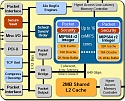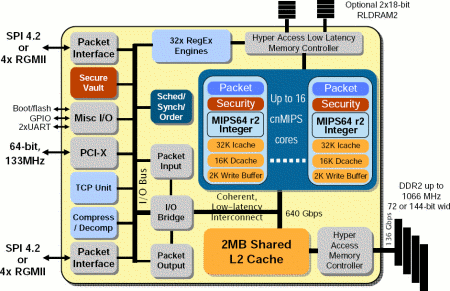Dual, quad-core MIPS64 SoCs boast Linux SDKs
Feb 12, 2008 — by Eric Brown — from the LinuxDevices Archive — 10 views Fabless networking semiconductor vendor Cavium announced faster Linux-compatible Octeon processors for entry- to mid-level networking, wireless base stations, and storage services applications. The Octeon Plus CN52XX MIPS64 family can provide up to 4Gbps of network throughput at under 10 Watts, says the company.
Fabless networking semiconductor vendor Cavium announced faster Linux-compatible Octeon processors for entry- to mid-level networking, wireless base stations, and storage services applications. The Octeon Plus CN52XX MIPS64 family can provide up to 4Gbps of network throughput at under 10 Watts, says the company.
The CN52XX line appears to fill a gap in Cavium's MIPS64 family of Octeon processors, now totaling about 30 different models. With its dual- and quad-core options, it provides a more powerful upgrade to Cavium's single- and dual-core CN50xx, while maintaining a lower price tag compared to its high-end four- to 16-core CN58XX chips.

Octeon architecture
(Click to enlarge)
The CN52XX processors can be clocked up to 900MHz (compared to 700MHz for the CN50XX). They offer integrated hardware acceleration for packet processing, Quality of Service (QoS), TCP, and security, says Cavium.
Additional features of the CN52XX include:
- Processor - two to four 64-bit cnMIPS cores, clocked at 500MHz to 900MHz
- Memory — 512KB of L2 cache; 72bit DDR2-800 memory controller
- Networking — up to 4 x gigabit Ethernet interfaces (SGMII), or one 10 Gigabit interface (XAUI); two MII management interfaces
- USB — 2 x USB 2.0 interfaces
- PCI — 2 x PCI-Express controllers with up to four lanes
The CN52XX processor family will include models aimed at secure routers, switches, wireless base stations, security appliances, and storage disk arrays and bridges. The network and wireless products target entry- to mid-level enterprises and access providers that are deploying applications that integrate data, voice and video over wired and wireless networks, says Cavium.
Initial CN52XX models target network equipment, wireless base stations, and storage services, respectively:
- The network model can process over 10Gbps of IP forwarding and NAT, says the company, while processing IPsec SSL security protocols at 5Gbps. The processor is said to support routing and switching functions, with Layer 2 to Layer 7 intelligence. Security features include access control, WAN gateway functions, firewall, intrusion protection, and VPN.
- The wireless processor version is designed for next-generation wireless base stations that need to support converging services such as 3G transport, 4G transport or LTE (Long Term Evolution), Wireless LAN aggregation, and WiMAX. The CN52XX addresses all the L2-L7 requirements for Pico, Micro, and Macro Basestations, says the company, while its higher end CN54XX/56XX product family covers Macro basestations, RNC, and xGSN core transport.
The wireless CN52XX offers over 1Gbps of WiMax base station protocol performance, AAL2, and over 4Gbps of min packet routing, says Cavium. It is also said to provide robust header compression (RoHC), Kasumi for over-the-air encryption, and IPsec for wired links.
- The storage-services version of the CN52XX integrates up to 7000 MIPS, says the company, and can process over 500MB/s of IEEE 1619 for data-at-rest security, as well as 100K iSCSI IOPS-to-disk. It offers integrated advanced hardware acceleration for storage IOPS, TCP, iSCSI, RAID 6, de-duplication and security. The processor is designed for entry and mid-level storage systems such as:
- iSCSI targets
- Fiber-Channel to iSCSI bridges
- Fiber Channel over Ethernet adaptors
- Disk encryption controllers
- Disk arrays
- RAID 6 arrays
- De-duplication enabled systems
All the CN52XX versions are supported by Cavium's software development kit (SDK), which is based on SMP Linux 2.6 distributions from MontaVista or Wind River. The SDK includes the GNU Toolchain, debugger tools, co-processor acceleration APIs, reference software, and more.
Availability
Pricing for the Octeon CN52XX processors starts at $50 in 10K quantities, says Cavium. General samples for the processors and respective evaluation boards will be available in the second quarter. More information is available here.
This article was originally published on LinuxDevices.com and has been donated to the open source community by QuinStreet Inc. Please visit LinuxToday.com for up-to-date news and articles about Linux and open source.